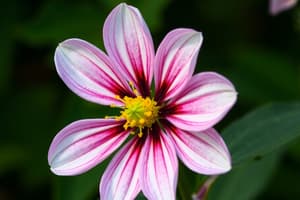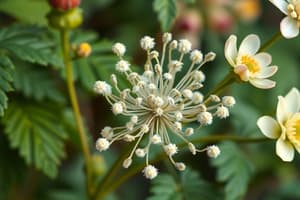Podcast
Questions and Answers
What is the main function of roots in a plant?
What is the main function of roots in a plant?
- To absorb water and minerals (correct)
- To provide support and structure
- To carry out photosynthesis
- To synthesize glucose
Which type of plant has a permanent woody stem and survives winter as dormant buds?
Which type of plant has a permanent woody stem and survives winter as dormant buds?
- Herbaceous plant
- Woody plant (correct)
- Epiphyte
- Succulent
What is the process by which plants convert light energy into chemical energy?
What is the process by which plants convert light energy into chemical energy?
- Photosynthesis (correct)
- Support and Structure
- Transpiration
- Respiration
What is the function of vascular tissue in a plant?
What is the function of vascular tissue in a plant?
Which type of plant has thick, fleshy leaves that store water?
Which type of plant has thick, fleshy leaves that store water?
What is the process by which plants break down glucose to produce energy?
What is the process by which plants break down glucose to produce energy?
What is the function of stomata in a plant?
What is the function of stomata in a plant?
Which type of tissue provides protection and regulation in a plant?
Which type of tissue provides protection and regulation in a plant?
What is the primary function of cerebrospinal fluid?
What is the primary function of cerebrospinal fluid?
Which of the following is NOT a type of extracellular fluid?
Which of the following is NOT a type of extracellular fluid?
What is the primary function of blood platelets?
What is the primary function of blood platelets?
Which of the following is a function of the circulatory system?
Which of the following is a function of the circulatory system?
What is the term for the pressure during heart relaxation?
What is the term for the pressure during heart relaxation?
Which of the following types of fluid is found in the eye?
Which of the following types of fluid is found in the eye?
What is the term for the circulation of oxygen-rich blood from the heart to the body tissues?
What is the term for the circulation of oxygen-rich blood from the heart to the body tissues?
What is the percentage of blood volume made up of plasma?
What is the percentage of blood volume made up of plasma?
Flashcards are hidden until you start studying
Study Notes
Forms of Plants
- Herbaceous plants: non-woody plants, die back to the ground at the end of the growing season
- Examples: grasses, herbs, vegetables
- Woody plants: plants with a permanent woody stem, survive winter as dormant buds
- Examples: trees, shrubs, vines
- Succulents: plants with thick, fleshy leaves that store water
- Examples: cacti, aloe, echeveria
- Epiphytes: plants that grow on other plants, but not parasitic
- Examples: orchids, bromeliads, air plants
Functions of Plants
- Photosynthesis: process by which plants convert light energy into chemical energy
- Occurs in chloroplasts, requires water, carbon dioxide, and light
- Respiration: process by which plants break down glucose to produce energy
- Occurs in mitochondria, produces carbon dioxide and water as byproducts
- Transpiration: process by which plants transport water and minerals from roots to leaves
- Occurs through xylem vessels, regulated by stomata
- Support and Structure: plants provide support and structure through their stems, roots, and leaves
- Examples: trees provide shelter, herbs provide medicine, grasses provide food
Plant Organs
- Roots: underground organs that absorb water and minerals
- Functions: anchorage, absorption, storage
- Stems: above-ground organs that support leaves and transport materials
- Functions: support, transportation, storage
- Leaves: organs that carry out photosynthesis
- Functions: photosynthesis, transpiration, storage
Plant Tissues
- Dermal tissue: outermost layer of plant, provides protection and regulation
- Functions: protection, regulation of water loss
- Ground tissue: inner tissue that provides support and storage
- Functions: support, storage, synthesis
- Vascular tissue: tissue that transports water, minerals, and sugars
- Functions: transportation, support
Forms of Plants
- Herbaceous plants are non-woody, die back to the ground at the end of the growing season, and include examples like grasses, herbs, and vegetables.
- Woody plants have a permanent woody stem, survive winter as dormant buds, and include examples like trees, shrubs, and vines.
- Succulents have thick, fleshy leaves that store water, and include examples like cacti, aloe, and echeveria.
- Epiphytes grow on other plants, but are not parasitic, and include examples like orchids, bromeliads, and air plants.
Plant Processes
- Photosynthesis is the process by which plants convert light energy into chemical energy, occurring in chloroplasts and requiring water, carbon dioxide, and light.
- Respiration is the process by which plants break down glucose to produce energy, occurring in mitochondria and producing carbon dioxide and water as byproducts.
- Transpiration is the process by which plants transport water and minerals from roots to leaves, occurring through xylem vessels and regulated by stomata.
Plant Organs
- Roots are underground organs that absorb water and minerals, providing anchorage, absorption, and storage.
- Stems are above-ground organs that support leaves and transport materials, providing support, transportation, and storage.
- Leaves are organs that carry out photosynthesis, providing photosynthesis, transpiration, and storage.
Plant Tissues
- Dermal tissue is the outermost layer of plant, providing protection and regulation of water loss.
- Ground tissue is the inner tissue that provides support and storage, synthesizing new compounds.
- Vascular tissue transports water, minerals, and sugars, providing transportation and support.
Body Fluids
- There are two main types of body fluids: intracellular fluid (ICF) and extracellular fluid (ECF)
- ICF is fluid within cells, while ECF is fluid outside cells
- ECF is further divided into:
- Interstitial fluid (between cells and tissues)
- Blood plasma (fluid portion of blood)
- Cerebrospinal fluid (surrounding the brain and spinal cord)
- Synovial fluid (in joints and tendons)
- Aqueous humor (in the eye)
- Endolymph and perilymph (in the inner ear)
- Body fluids regulate body temperature, transport nutrients and oxygen, and maintain pH and electrolyte balance
- They also lubricate joints and other tissues and support immune function
Circulation
- The circulatory system consists of the heart, arteries, veins, capillaries, and blood
- The heart pumps blood throughout the body
- Arteries carry oxygenated blood away from the heart, while veins carry deoxygenated blood back to the heart
- Capillaries are tiny blood vessels where oxygen and nutrients are exchanged with tissues
- Blood is a fluid tissue that transports oxygen, nutrients, and waste products
- There are two main circuits in blood circulation: pulmonary and systemic
- Pulmonary circulation involves oxygen-depleted blood from the body to the heart to the lungs and back to the heart as oxygen-rich blood
- Systemic circulation involves oxygen-rich blood from the heart to the body tissues and back to the heart as oxygen-depleted blood
- Blood pressure is regulated by the autonomic nervous system, baroreceptors, and hormones
- Systolic pressure is the pressure during heart contraction, while diastolic pressure is the pressure during heart relaxation
Blood Composition
- Blood is composed of plasma (55% of blood volume) and formed elements (45% of blood volume)
- Plasma contains water, proteins, nutrients, waste products, and hormones
- Formed elements include red blood cells (RBCs), white blood cells (WBCs), and platelets
- RBCs carry oxygen, WBCs are part of the immune system, and platelets are involved in blood clotting
- Blood types are determined by the ABO system, Rh factor, and other antigens, which determine blood compatibility
Studying That Suits You
Use AI to generate personalized quizzes and flashcards to suit your learning preferences.




